Welcome to the June 2020 edition of the Curious Tea subscription! This month we are focusing solely on China and presenting all teas from the latest 2020 harvest. Here’s a closer look at the four exciting new teas that we are sharing with our subscribers this month.
The first light tea this month is a classic Tie Guan Yin Iron Goddess of Mercy Oolong tea from Anxi County of Fujian Province that displays a fine interplay between floral and vegetal notes.
The second light tea is another classic tea from China, this time from the famous Huang Shan of Anhui Province, a particularly light Mao Feng green tea that is made from fine young leaves.
For the dark side of the selection we have a Mi Lan Xiang ‘Honey Orchid Aroma’ Dan Cong Oolong from Guangdong Province that has a complex profile, bursting with flavours.
Finally, the last tea we are featuring this month is a rare ‘Flower Aroma’ Hua Xiang Lao Cong Xiao Zhong that is picked from semi-wild old trees grown on the rocky terrain on Wu Yi Shan in Fujian Province.
- Light: Tie Guan Yin Iron Goddess of Mercy Oolong and Huang Shan Mao Feng;
- Dark: Dan Cong Mi Lan Xiang Oolong and Hua Xiang Lao Cong Xiao Zhong;
- Mixed: Tie Guan Yin Iron Goddess of Mercy Oolong and Dan Cong Mi Lan Xiang Oolong.
Our Discovery subscription boxes contain 10g taster pouches of all of the above mentioned teas. If you are a subscriber you will benefit from a 10% discount on all teas from our tea shop!
Let’s get into further detail on the products featured in our June tea subscription boxes.
Tie Guan Yin Iron Goddess of Mercy Oolong
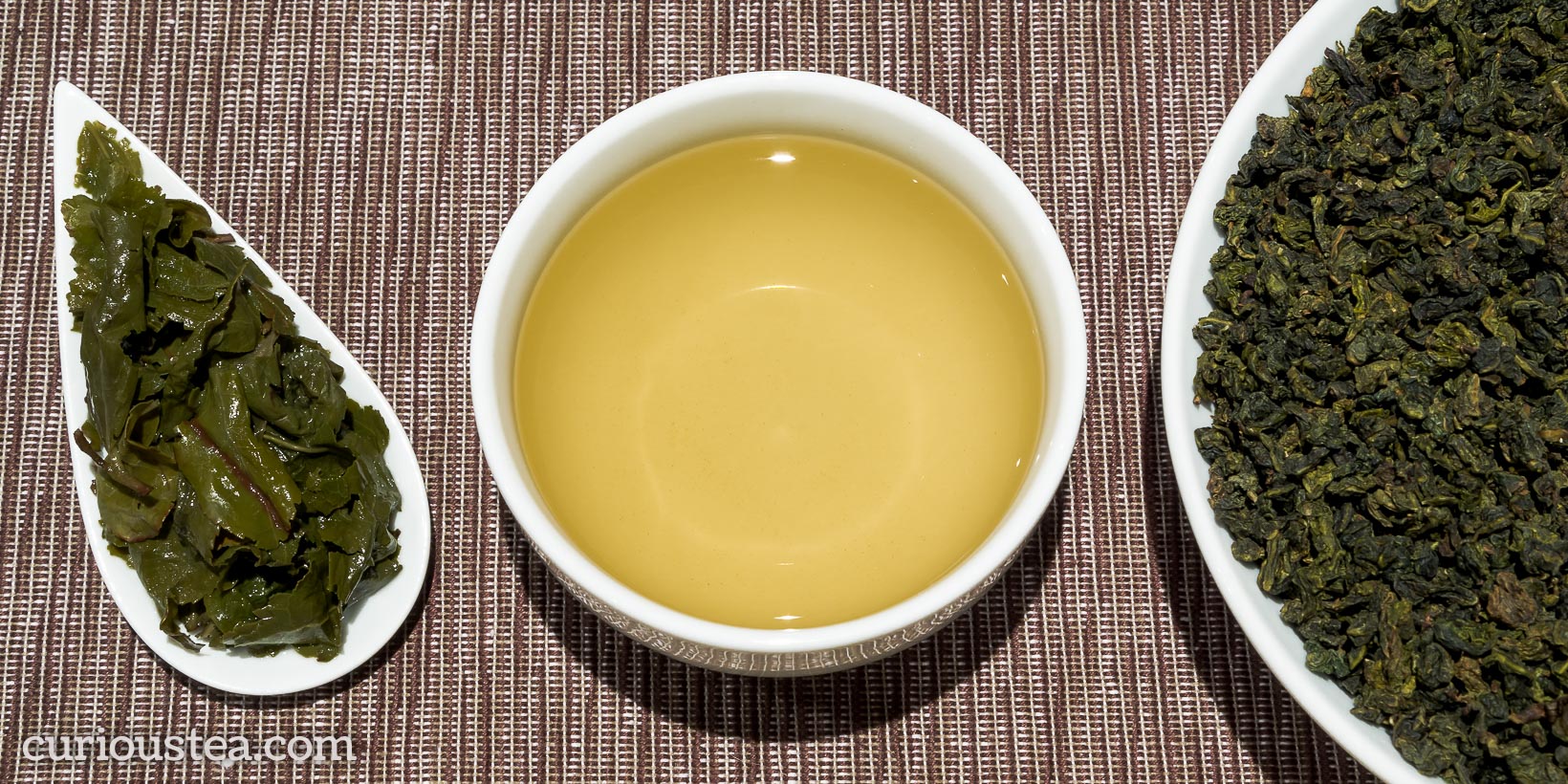
Our Tie Guan Yin (铁观音) Iron Goddess of Mercy is a premium version of a truly classic Chinese oolong. This one comes from Anxi County in Fujian Province, the birthplace of this very famous and popular tea. This Tie Guan Yin Oolong is an Anxi-style tea, which means that it is lightly oxidised, retaining many of the delicate floral aspects that are a closer to a light green tea without the grassiness or astringency. This type of oolong has become known as a ‘jade’ or ‘green’ oolong due to the light appearance and colour that is reflected both in the leaves of this tea as well as the light coloured liquor. This particular crop of our Tie Guan Yin Iron Goddess of Mercy oolong was plucked in spring, May 2020, in Anxi County of Fujian Province in China.
The tea is named after the Chinese name for the bodhisattva known as Avalokiteśvara, Guan Yin (观音). Guan Yin is a bhuddist bodhisattva usually associated with compassion; it is also known in Japan as Kannon Bosatsu (観音菩薩) and in Korea as Gwan-eum (관음). Other spellings and names for this tea include TGY, Ti Kuan Yin, Tit Kwun Yum, Ti Kwan Yin, Iron Buddha, Iron Goddess Oolong and Tea of the Iron Bodhisattva. The English name ‘Iron Goddess of Mercy’ is a literal translation of ‘Tie Guan Yin’ and is the most common English name for this Chinese oolong.
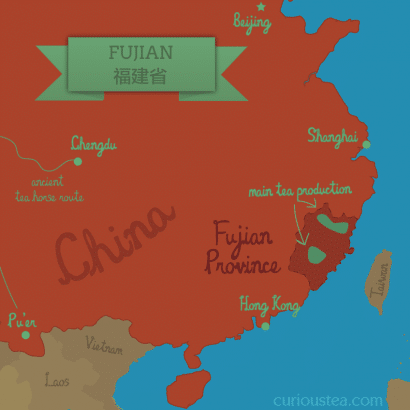
There are two legends that explain the origin of the name of Tie Guan Yin Iron Goddess of Mercy oolong. One tells a story of a scholar called Wang who discovered a tea plant under Guan Yin rock, brought it home and then cultivated this tea. When he brought this tea to the Emperor as a gift, the Emperor liked the tea so much he wondered where this tea originated. As it was found under the Guan Yin rock, it was decided to call it Guan Yin tea.
Another legend tells a story of a poor farmer called Wei. There was a temple with an iron statue of Guan Yin on the way from the tea fields that Wei walked past every day and he noticed that the condition of the temple was worsening. He decided to do something about it so he took it upon himself to clean the temple and light incense in it twice a week; he proceeded to do that over many months. One night Guan Yin appeared to him in his dream telling him that there was a cave behind the temple with treasure that awaited him. Upon entering the cave Wei discovered a tea plant shoot. He planted it in his field and nurtured it into a large tea bush. This tea plant produced the finest tea, so he shared the cuttings from this bush with all his neighbours. Wei and his neighbours started making and selling this fine tea under the name Tie Guan Yin. As they prospered from it, they were able to fully repair their beautiful temple.
This oolong undergoes a complex production process that results in quite a characteristic tea and is shared with other light Anxi-style oolong teas. The processing goes through the following stages: plucking of tea leaves, sun withering, cooling, tossing, withering with slight oxidation, further tossing and withering, fixation, rolling, drying, sorting and finally packing. As the tea nears the completion of this process, the distinctive colouration of the leaves becomes apparent. This can be seen on the dried leaves, they become quite light in colour on the edges, almost frosted in places. This is a distinguishable feature of a well-made and correctly processed Tie Guan Yin Iron Goddess of Mercy oolong.
The tightly rolled light green, jade coloured leaves of this Tie Guan Yin Iron Goddess of Mercy oolong have a slight green floral aroma. When brewed, the leaves unfurl, producing a pale golden clear liquor with a floral scent. The taste is light, with a pronounced floral profile and refreshing flavours of fresh green vegetables with a buttery note and a little sweetness reminiscent of red peppers. The lasting aftertaste has more floral flavours. This is a light and refreshing tea with a smooth and balanced flavour and no bitterness or astringency.
This oolong is best brewed at 90°C for around 3 minutes according to your taste and can be brewed more than 3 times, increasing steeping time with each next brew if desired.
You can discover all four famous Anxi oolongs in our online shop: classic Tie Guan Yin Iron Goddess of Mercy, crisp and zesty
Mao Xie Hairy Crab, refreshingly floral Ben Shan Source Mountain and the most floral Huang Jin Gui Golden Osmanthus.
Huang Shan Mao Feng
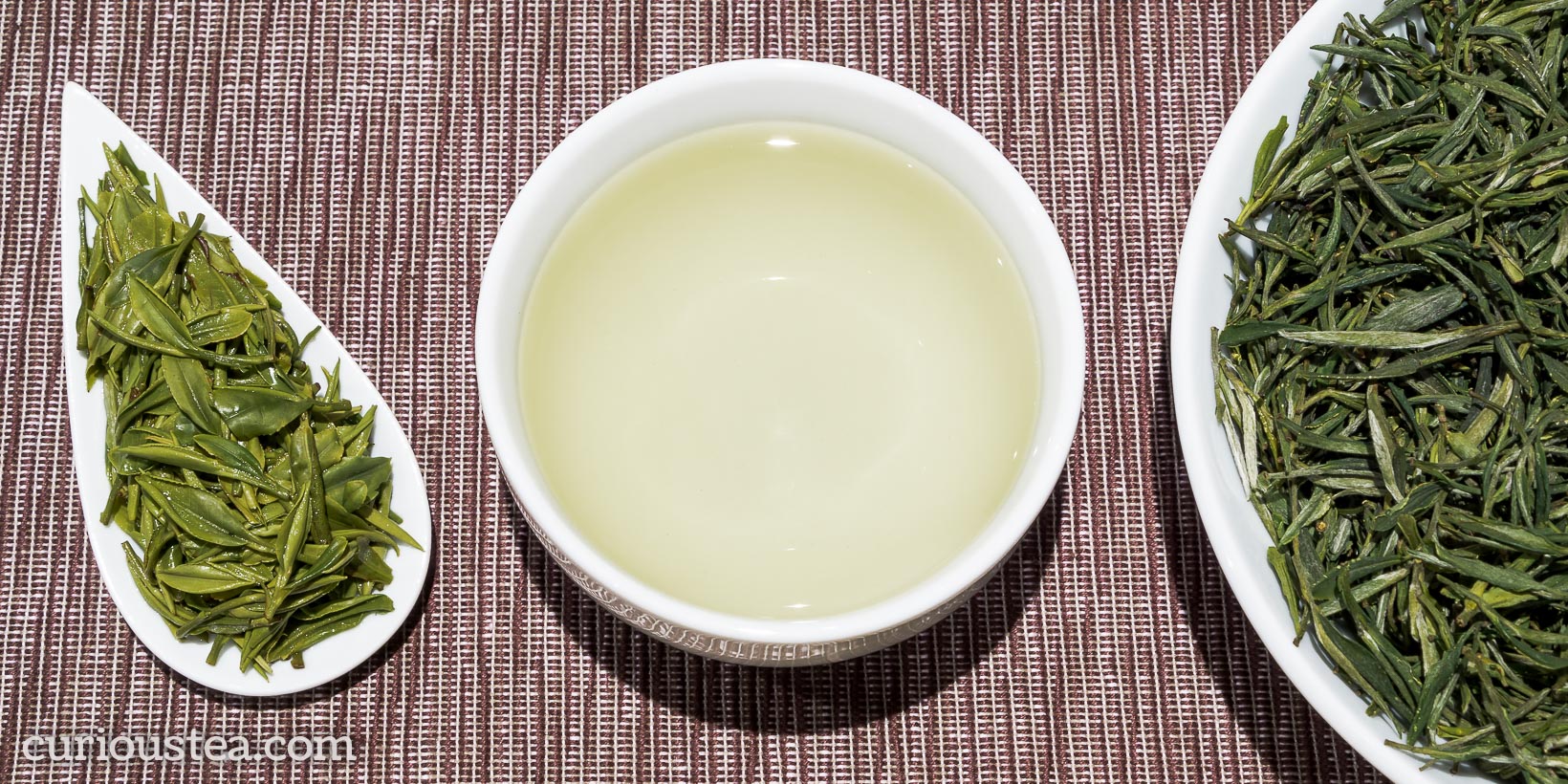
Huang Shan Mao Feng (黃山毛峯) is a supreme green tea produced in south-eastern part of Anhui Province of China. This is a highly regarded tea that can almost always be found on most of the lists for famous teas of China. This Mao Feng is characteristically light, with sweet vegetal notes and a particularly smooth taste. Grown at an elevation of over 800m, it was picked around 7th April 2020.
This tea is grown at the foot of Huang Shan ‘Yellow Mountain’ (黃山) mountain range, an area that is famous for green tea production. Huang Shan not only happens to be a popular tourist destination in China but is also an ideal location for tea growing. The cool and misty climate as well as mineral rich soil combine to produce flavoursome teas that have a high level of theanine and are rich in tannins and vitamins. Mao Feng (毛峯) translates into English as ‘Fur Peak’, referring to the small white hairs that cover the young dry leaves. So the full name of Huang Shan Mao Feng green tea is normally translated into English as ‘Yellow Mountain Fur Peak’.
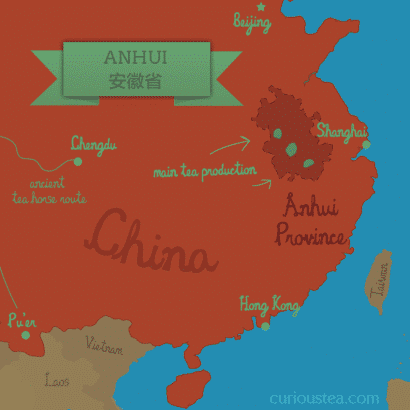
This Huang Shan Mao Feng green tea was hand picked using only carefully selected young leaves. The finished dry leaves are mostly whole, exhibiting a bud plus one or two young leaves. The appearance of them is very straight and pointed, the result of the skilful processing. Utilising the buds and the smallest of the leaves results in a particularly delicate tea.
The long green leaves of Huang Shan Mao Feng tea produce a pale liquor with a light floral aroma. A brilliantly clean and refreshing tea, it is also smooth and balanced. It is mild with no astringency and it has a light, mouth-watering aftertaste. The profile is vegetal and a little grassy, with a savoury undercurrent. The taste further develops with sweeter notes and light flavours of fruits, such as apricots and peaches.
This green tea is best brewed at 80°C for 2-3 minutes according to your taste and can be brewed more than 3 times, increasing steeping time with each next brew if desired. This method produces a light and mild liquor. It is also possible to brew for longer or use larger proportion of leaves to water for a stronger flavour. 5g to 250ml of water, at 80°C for 1 minute for a lighter flavour and 2 minutes for a stronger flavour.
You can also buy Huang Shan Mao Feng green tea in our online shop.
Dan Cong Mi Lan Xiang Oolong
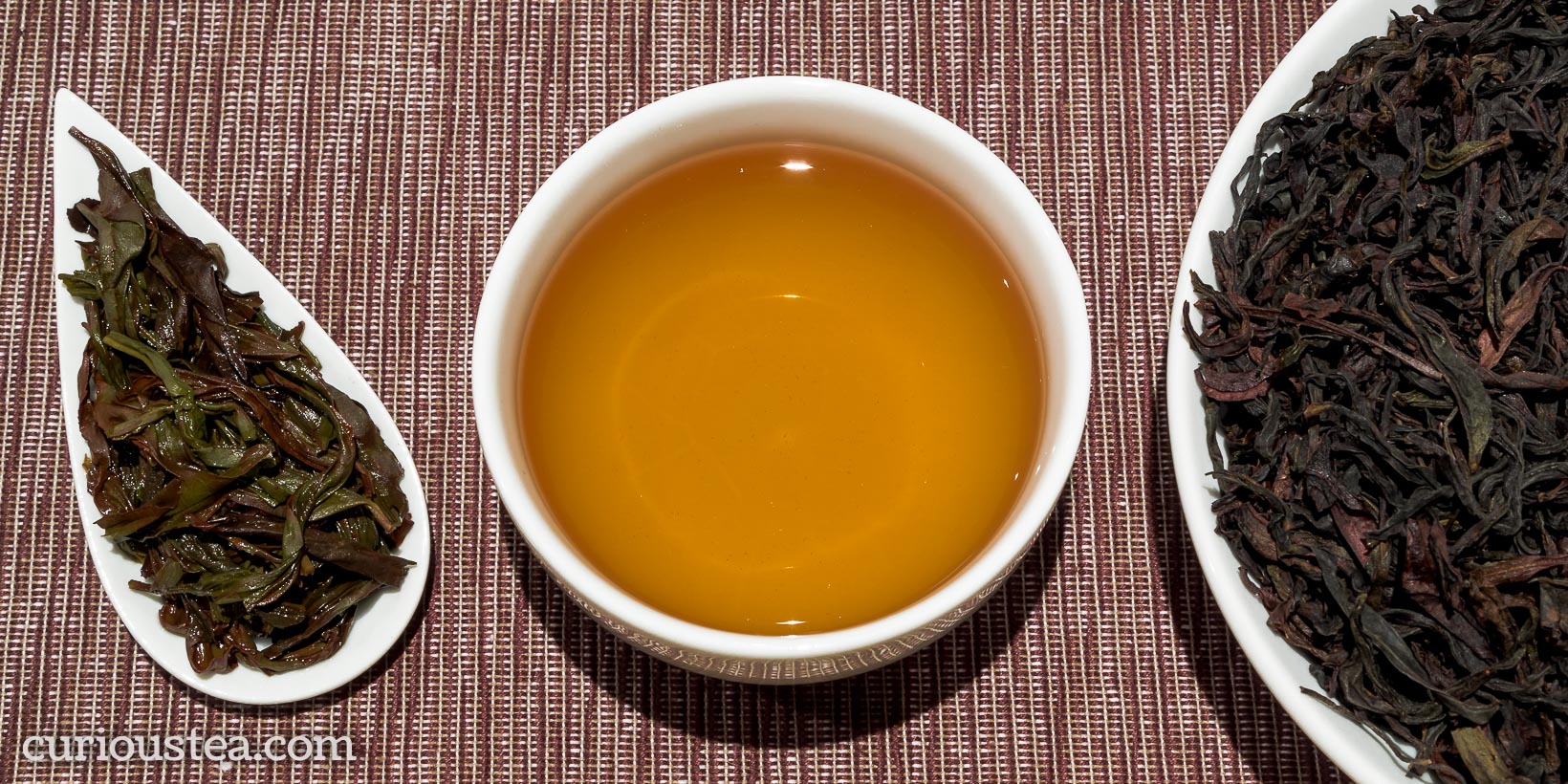
Dan Cong Mi Lan Xiang Oolong (单枞蜜兰香), known as Honey Orchid Fragrance Phoenix Oolong, is an excellent example of a Dan Cong Oolong – a famous style of tea from Guangdong Province in Southern China. This is a traditional Mi Lan Xiang oolong that has a pronounced floral and honey aroma and taste, complete with a complex aftertaste that is mineral and lightly roasted. It is grown in the Phoenix Mountain area near Chaozhou City (Phoenix Town) in Guangdong Province at an altitude of about 1,000-1,500 metres on the rocks of Wu Dong Mountain. Picked from semi-wild trees of the Shui Xian cultivar that are about 30 years old, the current batch is from April 2020 harvest.
Dan Cong Oolongs are noted for their ability to imitate various flavours, be it flowers or fruits. This is a natural characteristic developed through selecting specific tea trees and applying specific processing techniques. The aroma and taste differences of Dan Cong Oolongs are mostly introduced during the finishing process of each tea. The skills of the tea master are therefore paramount in how each batch of tea turns out. This Mi Lan Xiang Dan Cong Oolong for example is noted for its ‘Honey Orchid’ aroma and flavour.
Dan Cong (单枞) is the general name that is used to refer to oolongs that come from Guangdong and specifically from Phoenix Mountain. Dan Cong literally means ‘single bush’ as traditionally these oolongs were all picked only from single trees. Each batch would be picked from only one tree and sold as such, without mixing of leaves from different trees, in order to preserve the unique flavour and experience of each specific tree. Of course while it is possible to still find teas that really are ‘single bush’, the reality is that they are extremely rare and expensive. However tea masters are still able to achieve a specific taste even with mixing of the leaves from different trees through skilful traditional tea processing techniques.
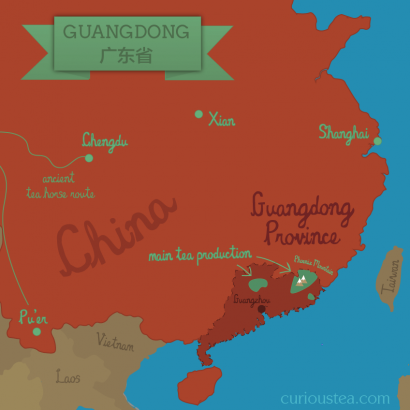
Many types of Dan Cong teas have been developed, all with unique characteristics and flavours. Mi Lan Xiang is probably amongst the most famous and recognised types. Now with the changing of processing techniques the term Dan Cong has become more of a generic term to cover all Phoenix Mountain (Feng Huang Shan 凤凰山) and sometimes other Guangdong Oolongs. Phoenix oolongs are very varied in style and flavour but are often sold just as ‘Phoenix Mountain Oolong’ or ‘Phoenix Dan Cong’ often not specifying the exact type of Dan Cong or where it is from. Make sure to look out for which particular Dan Cong you are buying as they all have varying characteristics and styles depending on where and how they are grown and processed.
The semi-wild tea trees that are used to produce this tea are Feng Huang Shui Xian ‘Water Lily’ (凤凰水仙) cultivar bushes. Shui Xian is also known as ‘narcissus’ or ‘water sprite’. The Shui Xian cultivar is present both around Feng Huang Shan (凤凰山) in Guangdong Province and in Wu Yi Shan (武夷山) in Fujian Province and in both locations it is responsible for producing some of the best and most enigmatic oolong teas in the world. There is some debate as to whether Shui Xian originated in Guangdong or in Fujian, however the terroir greatly affects the final outcome with each region producing quite distinctive teas. The semi-wild nature of the trees means that they are left to grown naturally on rocky mountainsides. The age of the trees, the natural biodiverse growing conditions and rocky terrain attribute to slower leaf growth and higher concentration of flavour. The trees are able to absorb more nutrients concentrating these in the leaves and resulting in a powerful and flavoursome tea.
The dark and twisted dry leaves of this Dan Cong Mi Lan Xiang Oolong produce a medium golden liquor. The aroma is quite floral, with a lightly baked edge. The taste of this tea is quite exceptional and shows off the true nature of a Dan Cong oolong. The main profile is that of wild honey, with notes of exotic flowers and fruits. The aftertaste is complex and lasting, with a lightly roasted touch. There is a mineral edge to the aftertaste that can be attributed to the semi-wild nature of the trees as well as their age. This tea is good to drink straight away but would also benefit from resting for up to 1-2 years to mellow and develop the flavours.
This Dan Cong Mi Lan Xiang Oolong can stand many infusions. Infuse it the western way in a tea pot at 90°C for 3 minutes 3+ times. If you are finding that your tea is turning out a little too astringent, you can reduce the brewing time or temperature until you reach your preferred taste. This tea would particularly benefit from traditional Gong Fu style brewing, yielding a lot more infusions, each bursting with flavour. It is a fascinating way of seeing how the tea changes with each infusion.
You can also buy Dan Cong Mi Lan Xiang Oolong tea in our online shop.
Hua Xiang Lao Cong Xiao Zhong
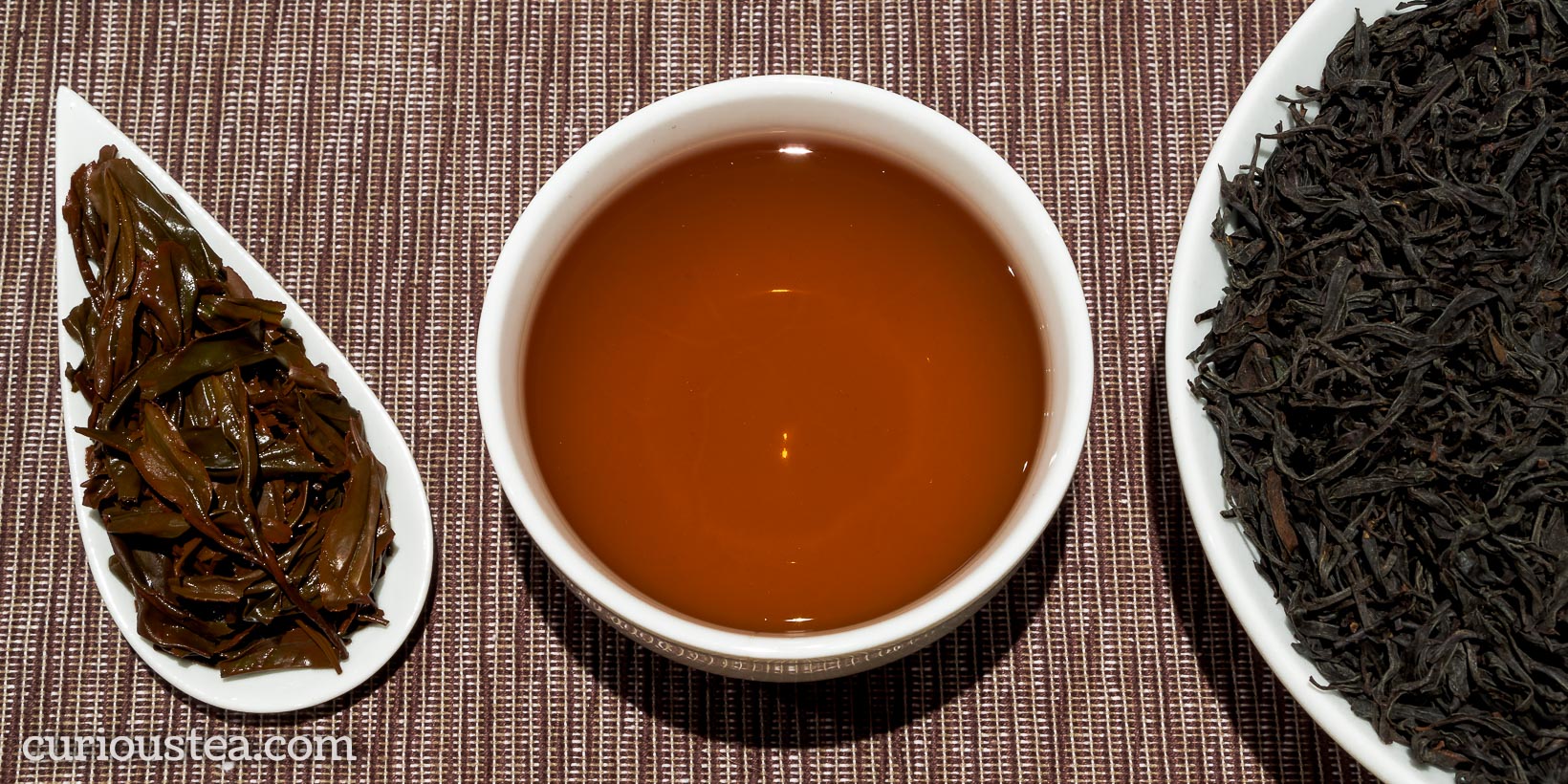
Hua Xiang Lao Cong Xiao Zhong (花香老枞小種) ‘Flower Fragrance Old Tree Small Leaf’ is an intriguing and unusual black tea from the mountainous terrain of Wu Yi Shan (武夷山). Grown around Tong Mu Village, famous for producing the best Jin Jun Mei and Lapsang Souchong, it is picked from semi-wild 30+ year old trees that grow on rocky mountain slopes. This tea produces a complex liquor with flavours that are savoury, spicy and mineral, yet showing a lasting sweet aftertaste. Spring 2020 harvest.
While Lapsang Souchong is the famous smoked tea hailing from Tong Mu Village, the area also produces some fantastic unsmoked black teas. Zheng Shan Xiao Zhong is a prime example of this local speciality, however we would class that as an entry level tea. By comparison, this Hua Xiang Lao Cong Xiao Zhong stands out on two counts. First, it is known as Hua Xiang (花香), meaning flower aroma in Chinese. This is attributed to a particularly flowery edge. It is quite different to bright floral highlights you might find in lightly oxidised oolong teas, displaying a more complex, deeper and subtle flower aroma. And second, it is also classed as a Lao Cong (老枞) tea as it comes from old bushes that are at least 30 years old. While it cannot compete with 100+ year old bushes found in other areas, the old tree nature certainly leads to a distinctive mouthfeel and aftertaste.

The Xiao Zhong (小種) part of the name literally means ‘Small Leaf’, referring to the small leaf tea plant that is used to produce this tea. This type of plant is found around Wu Yi Shan and is used to make various black teas from this area. The Xiao Zhong tea plant is also known as Cai Cha (菜茶), a generic term that is used to describe tea plants that are native or indigenous to certain parts of China. While these types of plants have differentiating features in different regions, they are still not uniform due to normal natural variation in the plants. So Cai Cha or Xiao Zhong is not a specific cultivar but rather a type of a tea plant that can be found around Wu Yi Shan that has small leaves and appeared naturally and over long time as a result of natural hybridisation. In this way, it is similar to zairai plants in Japan or tea plants found in most of South Korea.
This Hua Xiang Lao Cong Xiao Zhong has dark, twisted, aromatic dry leaves. The dark amber liquor has good clarity and a savoury, spicy aroma. The savouriness comes through on the taste profile, with more notes of spices, roasted red peppers, tomato soup. There is a pleasant mineral aspect running through the taste reminiscent of the rock taste found in the best Wu Yi Shan oolong teas. The aftertaste is sweet, smooth and lasting. Overall this tea leaves a very smooth impression of complex savoury flavours that can attributed the leaves originating from semi-wild old trees.
It is best brewed at 90°C for 3-4 minutes, with multiple infusions. For best results, brew gong fu style.
You can also buy Hua Xiang Lao Cong Xiao Zhong black tea in our online shop.
We really do hope that you enjoy the tea selection for June and are looking forward to the selection in our next box. Our July box will have a recently introduced amazingly sweet and honey-like Yunnan White Moonlight tea that comes in cake form, a new Tamaryokucha from Japan, our popular Jin Ya Golden Buds tea from Yunnan and finally a new Thai Assamica black tea!
If reading this has made you curious about our teas, but you don’t yet subscribe to a monthly tea selection, you can sign up for our tea boxes in just a few clicks. We ship worldwide from London, UK.
We always love to hear from you, so if you have any questions, suggestions or just want to chat about tea, email us at contact@curioustea.com, via our Facebook page or via Twitter.
You can also follow us on Instagram for pretty tea photos.
Happy tea discoveries!


Loved the Hua Xiang Lao Cong Xiao Zhong, but can’t find it to buy more.
Thanks
Hi Chris. Yes we only have a very limited amount left at the moment – we will put it into our shop next week. But we will have more of it arriving in a month or so! Best wishes. Alex @ Curious Tea